By Douglas Pro – Ryan Miller
Cold-water bass fishing delivers some of the most exciting action of the year. Some of the largest fish of the season are caught during the cold months. This is when bass are schooling up and the big ones are in full-blown feeding mode. Fish the schools right and you’ll be guaranteed to catch some toads.
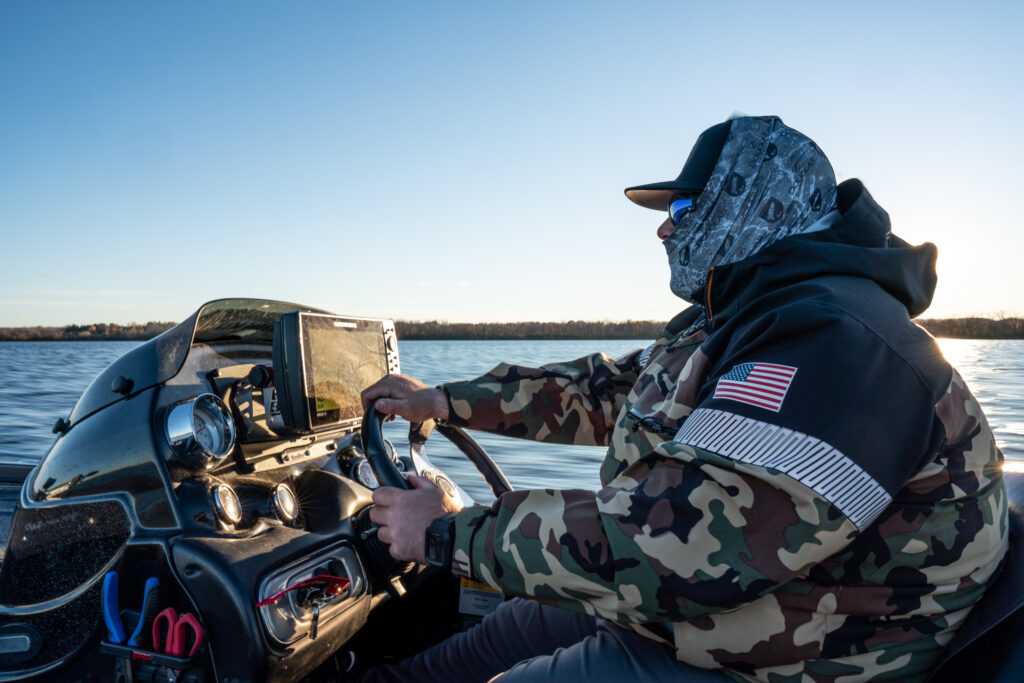
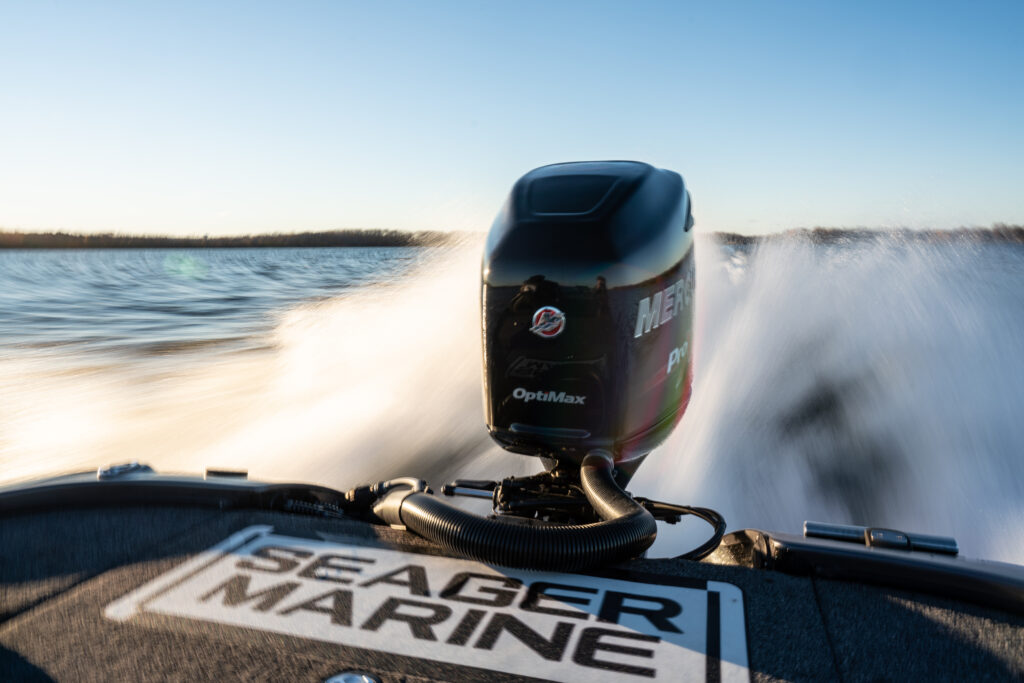
How to Catch Bass in Cold Water
When searching for bass in cold water, I mainly scout for three primary locations:
• Creek channels
• Shallow flats
• Rock piles
Creek channels provide runoff from the land surrounding the lake and bass tend to wait at the mouth of these channels to ambush prey. This is especially key after a front moves through bringing rain.
Shallow flats are good for locating those roaming fish that are on the hunt for an easy meal. Gobies, crayfish or baitfish tend to pile up on sand-to-rock transitions or shallow weed edges. Shallow flats are a natural stopping point.
Rock piles also play a key role as bass tend to hold near structure while looking to ambush prey. Secondary points should not be overlooked either.
Don’t get Beat Shallow
In the summer months, I tend to start in about 15 to 20-feet of water and progressively move deeper to locate fish. In the colder months, however, it is important not to overlook shallow water. This is especially true when water temps drop into the mid to low 50s.
You will likely find the bigger fish shallow. I have located smallmouth in as little as one foot of water eating crayfish. Bass boats are designed for shallow water. So trim that motor up and move in. My favorite bottom composition is riprap or boulder fields, as they provide the bait and bass places to hide.

Cold-water Bass Fishing Tips
The key to cold-water bass fishing is to keep moving. During the summer months, I tend to hit that spot-lock and fish structure. But during the winter, bass are going to be schooled up. So, it’s necessary to keep moving until you find active fish that will bite. This can be done by use of your trolling motor or my preferred method, drifting.
Drifting allows your bait to have a natural presentation, especially if you’re dragging or slow-rolling. You can usually find bass on the back-side of a hump or positioned on the downside of current or wind, waiting to eat as bait pushes over. Eliminating dead water can help you locate a bite that is worthwhile.
LiveScope plays a huge role in ruling out water for me. If I pitch my bait to a fish two or three times, and it doesn’t eat, I move on to an active fish.
This time of year can be the most challenging and rewarding for many anglers. Fish are constantly moving and strapping on the feed bag for the long winter months ahead. Don’t winterize those boats just yet. There’s still plenty of good water left and donkeys to catch!
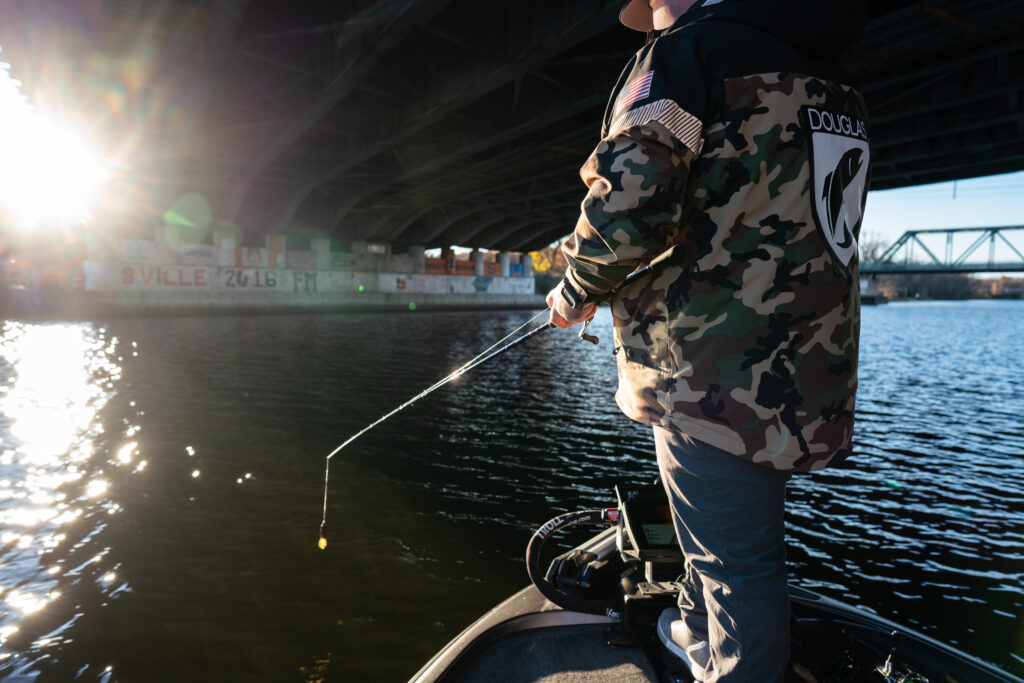
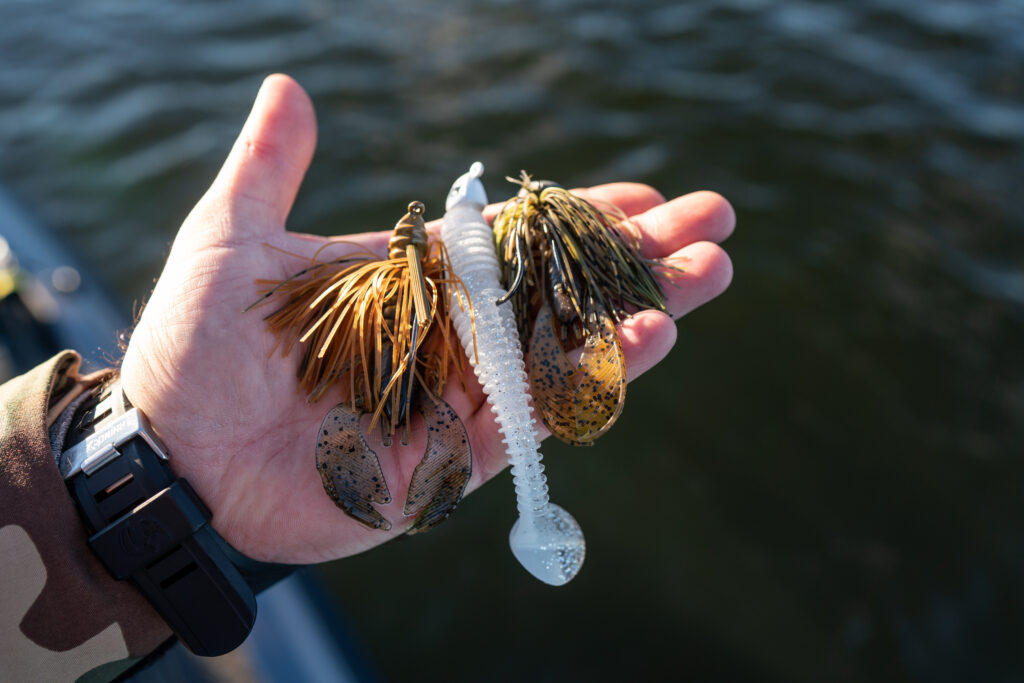
Best Lures for Cold-water Bass Fishing
Match the color, shape and size of your bait, to the main forage your fish are targeting. Size is very important this time of year. Below are a few of Ryan’s favorite setups to fish for cold-water bass.
Jig Setups:
- 1/8 oz, 1/4 oz, and 3/8 oz round jig heads/Swimbait Heads with a paddle tail in a natural baitfish color to match the prey.
- 1/8 oz with a 3.3 or 2.8 Keitech FAT Swing Impact (For shallow water and the upper 1/3 of the water column)
- 1/4 oz with a 3.8 Keitech FAT Swing Impact (For middle of the water column or suspended bass)
- 3/8 oz with a 3.8 or 4.3 Keitech FAT Swing Impact (For lower 1/3 of water column or fish that are hugging the bottom)
I prefer to use a round jig head, as the shape of it will displace water better than a swimbait head. This shape, paired with the rolling and thumping action of a paddle tail, is a deadly combination.
Best Rods: Douglas DXC 704M and Douglas DXC 715F
Preferred Line: 14lbs Sunline FC Sniper (fluorocarbon)
Alabama and Umbrella Rigs:
- Alabama Rig/Umbrella Rig- Brown Dog Tackle (junior size) https://www.browndogtackleco.com/shop/gunmetal-shad-alabama-rig
Jig Heads: Ensure your bottom two arms have a heavier head, for example, for shallow water (1-15 ft), both top arms and the center should have 1/16 oz to 1/8 oz heads, and the bottom two arms should have 1/4 oz heads.
Best Rod: Douglas LRS C7115F
Preferred Line: 20lbs Sunline FC Sniper (fluorocarbon).
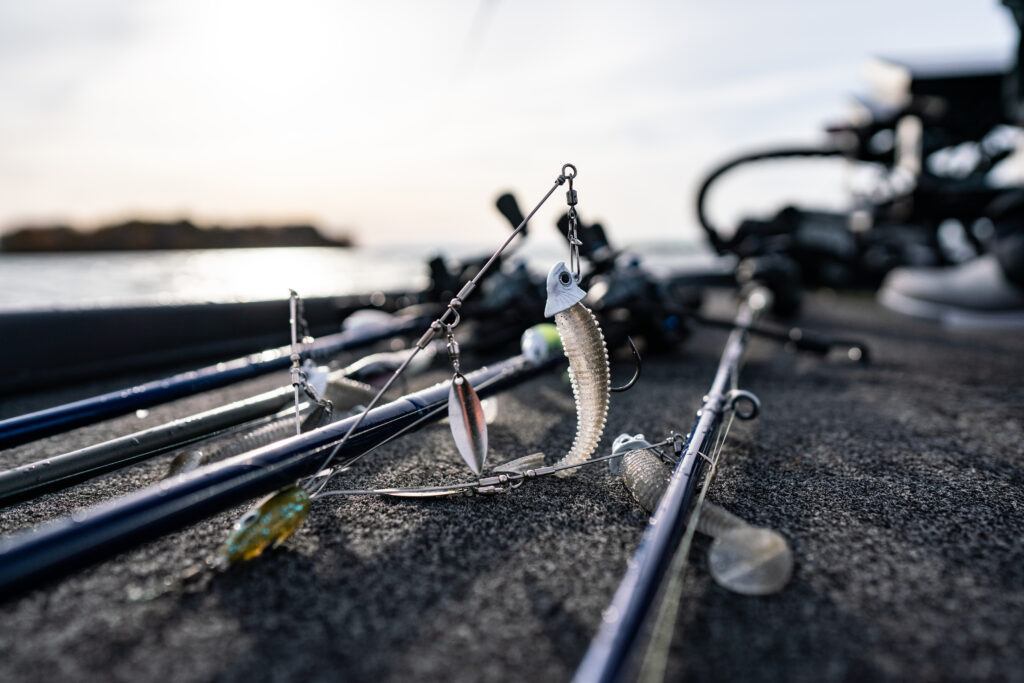
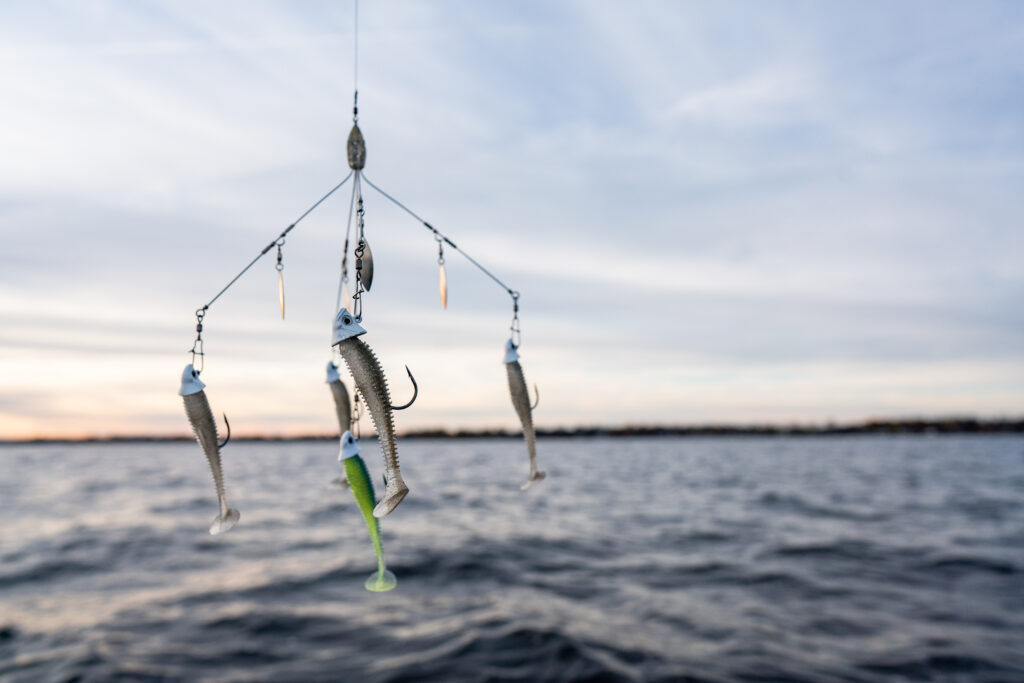
Additional Setups:
- Open water football jigs (without a weed guard, also referred to as finesse football jigs) https://www.beastcoastfishing.com/store/p395/Tungsten_Compound_O.W._Sniper_Football_Jig_-_MB_Pumpkin.html
- 3/8 oz Open Water Sniper from Beast Coast Fishing (important to use a trailer that matches the prey)
- Crayfish trailer: Fresh Baitz CrayCraw in Green Pumpkin or Black/Blue https://freshbaitz.com/collections/soft-baitz/products/craycraw-green-pumpkin
- Goby trailer: Beast Coast Fishing Magic Flick in Goby or Special Black Melon https://www.beastcoastfishing.com/store/p370/Magic_Flick_-_Goby.html
Best Rod: Douglas LRS SC724XF
Preferred Line: 10lbs Reaction Tackle X8 Hi Vis Yellow Braid with a 8lbs Sunline FC Sniper (fluorocarbon) leader.
- Blade Baits: i1baits Discoball or Frosty https://i1baits.com/products/blade-baits?variant=41188372807864
Best Rod: Douglas DXS 683XF
Preferred Line: 10lbs Reaction Tackle X8 Hi Vis Yellow Braid with a 20lbs Sunline FC Sniper (fluorocarbon) leader.
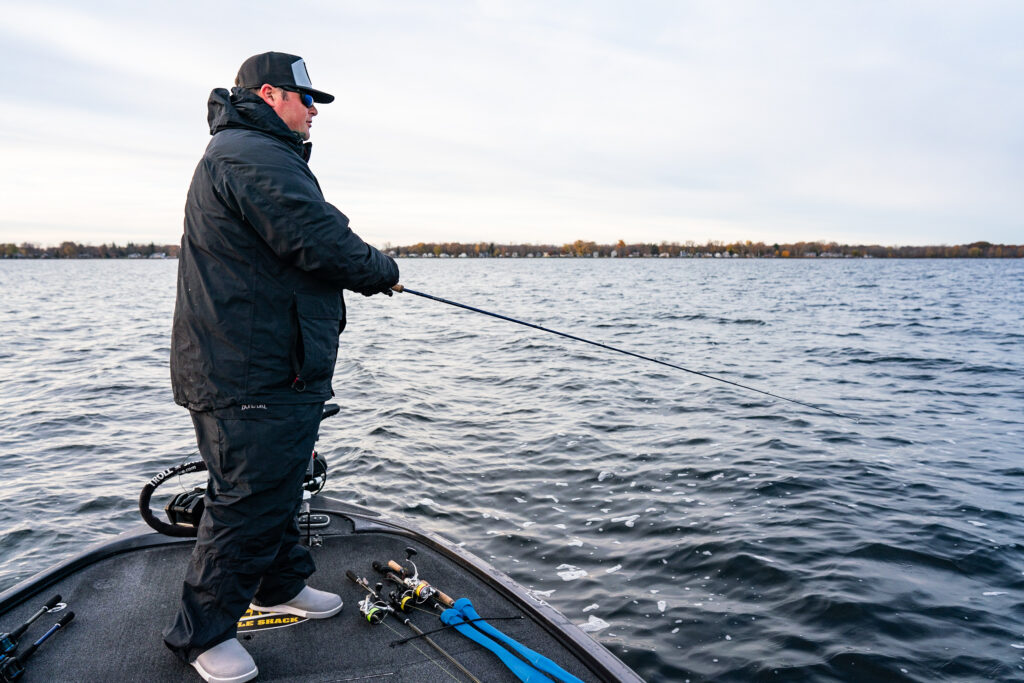
About Ryan Miller:
Ryan Miller is a man of many talents, but his love for giant bass stands above all else. Hailing from Upstate New York, Ryan dreams of clashing with record smallmouth and giant green heads. Always on the search, hunting and taking in the experience of the unknowns that each day on the water brings. Bass is not the only thing that Ryan seeks out. Trophy NY state perch are also on his radar in the “off” season. A multi-species angler like Ryan, in New York is a deadly combination that is on course for a clash of leviathans that roam the waters in the North, no matter the species.
When Ryan isn’t on the water, and not saving lives as a full-time Firefighter, He is honing his skills in the kitchen with dishes that would send Gordon Ramsey home with second helpings.
Connect with Ryan on Social Media:
Additional Resources:
- Learn How to Fish a Buzzbait
- Tips and Tactics for Early Spring Bass Fishing
- How to Fish a Carolina Rig
